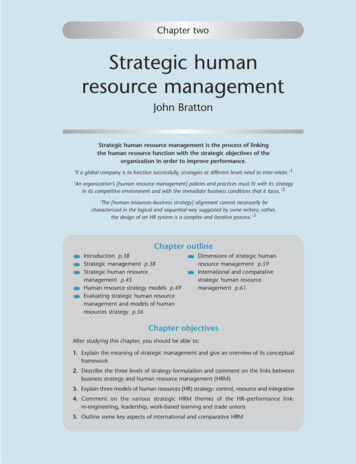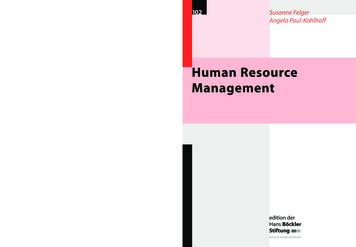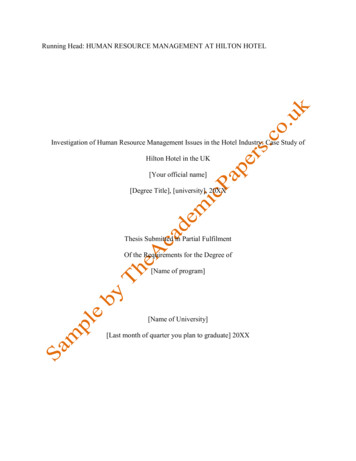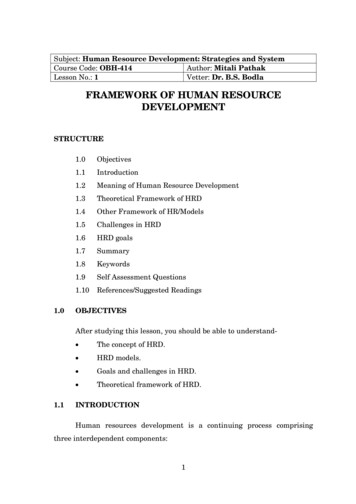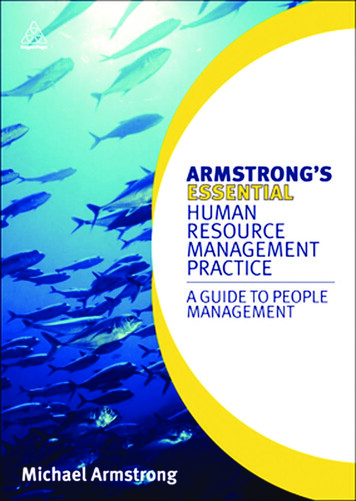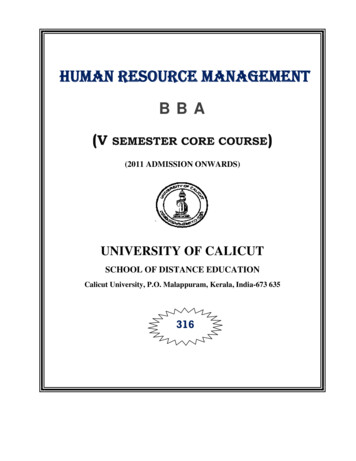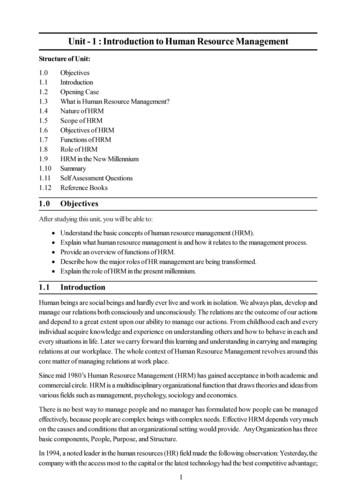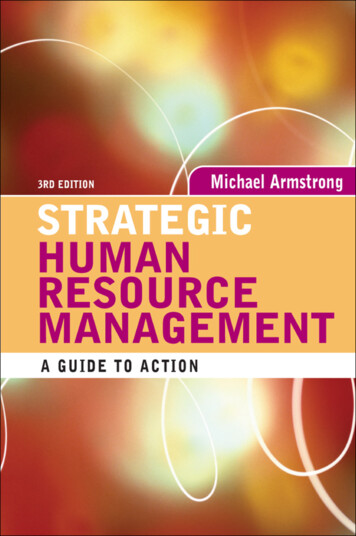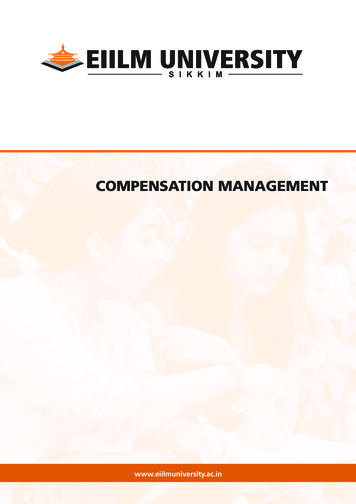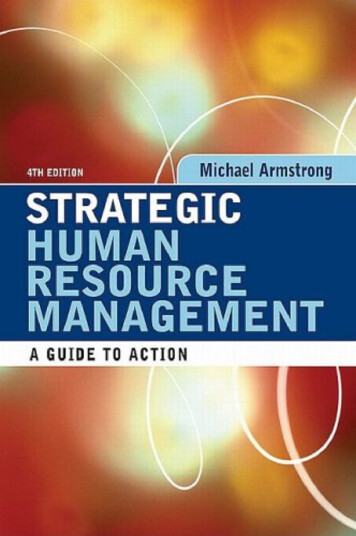
Transcription
iSTRATEGICHUMAN RESOURCEMANAGEMENT
iiFor free online support material please go to the Kogan Page website:www.koganpage.com/strategichrmPassword: SHRM53756
iiiSTRATEGICHUMAN RESOURCEMANAGEMENTA GUIDE TO ACTION4TH EDITIONMichael ArmstrongLondon and Philadelphia
ivPublisher’s noteEvery possible effort has been made to ensure that the information contained in this book isaccurate at the time of going to press, and the publishers and author cannot accept responsibility for any errors or omissions, however caused. No responsibility for loss or damage occasioned to any person acting, or refraining from action, as a result of the material in thispublication can be accepted by the editor, the publisher or the author.First published in Great Britain and the United States in 1992 as Human Resource Management:Strategy and ActionSecond edition published as Strategic Human Resource Management: A Guide to Action 2000Third edition 2006Reprinted 2006Fourth edition 2008Apart from any fair dealing for the purposes of research or private study, or criticism or review,as permitted under the Copyright, Designs and Patents Act 1988, this publication may only bereproduced, stored or transmitted, in any form or by any means, with the prior permission inwriting of the publishers, or in the case of reprographic reproduction in accordance with theterms and licences issued by the CLA. Enquiries concerning reproduction outside these termsshould be sent to the publishers at the undermentioned addresses:Kogan Page Limited120 Pentonville RoadLondon N1 9JNUnited Kingdomwww.koganpage.comKogan Page US525 South 4th Street, #241Philadelphia PA 19147USA Michael Armstrong, 1992, 2000, 2006, 2008The right of Michael Armstrong to be identified as the author of this work has been asserted byhim in accordance with the Copyright, Designs and Patents Act 1988.ISBN 978 0 7494 5375 6British Library Cataloguing-in-Publication DataA CIP record for this book is available from the British Library.Library of Congress Cataloging-in-Publication DataArmstrong, Michael, 1928–Strategic human resource management : a guide to action / Michael Armstrong. -- 4th ed.p. cmIncludes bibliographical references and index.ISBN 978-0-7494-5375-61. Personnel management. I. TitleHF5549.A89784 2008658.3 01--dc222008017601Typeset by Saxon Graphics Ltd, DerbyPrinted and bound in India by Replika Press Pvt Ltd
vContentsIntroductionPART 1 THE CONCEPTUAL FRAMEWORK OF STRATEGIC HRM1The concept of human resource managementHRM defined 5; Human resource systems 8; Aims of HRM 9;Characteristics of HRM 12; Reservations about HRM 1752The concept of strategyStrategy defined 22; The concept of strategy 23; The formulationof strategy 28213The concept of strategic human resource managementStrategic HRM defined 33; Basis of strategic HRM 34;Principles of strategic HRM 35; Aims of strategic HRM 35;Concepts of strategic HRM 37; Perspectives on strategic HRM 39;The best-practice approach 40; The best-fit approach 42;Bundling 46; The reality of strategic HRM 48; Practicalimplications of strategic HRM theory 4933
vi l ContentsPART 2 THE PRACTICE OF STRATEGIC HRM4 HR strategiesWhat are HR strategies? 53; What is the purpose of HRstrategies? 54; Overall HR strategies 54; Specific HR strategies 59;Criteria for an effective HR strategy 61; How should HRstrategies be developed? 62; Developing HR strategies 66;Implementing HR strategies 70535 The strategic role of HRThe strategic nature of HR 72; The strategic partner model 73;What being strategic means 75; The strategic role of HRdirectors 76; The strategic role of heads of HR functions 77;The strategic role of HR business partners 78; The strategiccontribution of HR advisers or assistants 78726 The impact of strategic HRMHow HR impacts on organizational performance 79;How strategic HRM concepts impact on practice 85797 Strategic HRM in actionFormulating HR strategy 86; The content of HR strategies 96;Corporate issues 98; Achieving integration 101; What are themost characteristic features of strategic HRM in action? 10486PART 3 HR STRATEGIES8 Human capital management strategy107Aims of human capital management 108; The link between HCMand business strategy 108; Developing a human capitalmanagement strategy 109; Conclusions: the role of human capitalmanagement strategy 1149 High-performance strategyHigh-performance work system defined 116; Characteristics of ahigh-performance work system 116; Components of anHPWS 117; Impact of high-performance work systems 117;Developing a high-performance strategy 12110 Corporate social responsibility strategyStrategic CSR defined 127; CSR activities 127; The rationale forCSR 128; Developing a CSR strategy 130115126
Contents l vii11Organization development strategy132Organization development defined 132; OD strategies 133;Assumptions and values of OD 133; Activities incorporated in theOD strategy 134; Strategies for organizational transformation 13612 Employee engagement strategyEngagement and organizational commitment 140; Thesignificance of engagement 141; Engagement and discretionarybehaviour 142; What is an engaged employee? 142; What are thefactors that influence engagement? 143; Strategies for enhancingengagement 145; Measuring engagement 14814013 Knowledge management strategyThe process of knowledge management 149; Sources and typesof knowledge 150; Approaches to the development of knowledgemanagement strategies 151; Strategic knowledge managementissues 151; Components of a knowledge managementstrategy 15314914 Employee resourcing strategyThe objective of employee resourcing strategy 154; The strategicHRM approach to resourcing 155; Integrating business andresourcing strategies 155; Bundling resourcing strategies andactivities 156; The components of employee resourcingstrategy 156; Human resource planning 157; Employee valueproposition 160; Resourcing plans 161; Retention strategy 163;Flexibility strategy 16715415 Talent management strategyTalent management defined 168; The process of talentmanagement 170; Developing a talent management strategy 17316816 Learning and development strategyStrategic human resource development (SHRD) 175; Strategiesfor creating a learning culture 178; Organizational learningstrategies 178; Learning organization strategy 180; Individuallearning strategies 18117517 Reward strategyReward strategy defined 183; Why have a reward strategy? 183;Characteristics of reward strategies 184; The structure of rewardstrategy 184; The content of reward strategy 185; Guidingprinciples 188; Developing reward strategy 189; Effective rewardstrategies 191; Reward strategy and line managementcapability 192183
viii l Contents18 Employee relations strategy193Employee relations strategy defined 193; Concerns of employeerelations strategy 194; Strategic directions 194; The background toemployee relations strategies 195; The HRM approach toemployee relations 195; Policy options 197; Formulatingemployee relations strategies 197; Partnership agreements 198;Employee voice strategies 200PART 4 THE STRATEGIC HR TOOLKIT1Strategic human resource management toolkit205References226Subject indexAuthor index241246
1IntroductionStrategic human resource management (SHRM) is an approach to the development and implementation of HR strategies that are integrated withbusiness strategies and enable the organization to achieve its goals.In essence, strategic HRM is conceptual; it is a general notion of how integration or ‘fit’ between HR and business strategies is achieved, the benefitsof taking a longer-term view of where HR should be going and how to getthere, and how coherent and mutually supporting HR strategies should bedeveloped and implemented. Importantly, it is also about how members ofthe HR function should adopt a strategic approach on a day-to-day basis.This means that they operate as part of the management team, ensure thatHR activities support the achievement of business strategies on a continuousbasis and are consciously concerned with seeing that their activities addvalue.To understand strategic HRM it is first necessary to appreciate theconcepts of human resource management and strategy as covered inChapters 1 and 2 respectively in Part 1 (the framework of strategic HR). Theconcept of strategic human resource management (strategic HRM) is thenexamined in detail in Chapter 3.Part 2 of the book is concerned with the roles of management and HR instrategic HRM and with the processes of developing and implementing HRstrategies. Part 3 covers each of the main areas of HR in which strategies aredeveloped. The book concludes with a toolkit providing guidance on developing HR strategy through a strategic review.
2THIS PAGE HAS BEEN INTENTIONALLYLEFT BLANK
3Part 1The conceptual frameworkof strategic HRM
4THIS PAGE HAS BEEN INTENTIONALLYLEFT BLANK
51The concept of humanresource managementIn the first section of this chapter human resource management (HRM) isdefined in general and as a system. Its aims and characteristics are describedin later sections of the chapter.HRM DEFINEDHuman resource management is defined as a strategic and coherentapproach to the management of an organization’s most valued assets – thepeople working there, who individually and collectively contribute to theachievement of its objectives.Boxall et al (2007) describe HRM as ‘the management of work and peopletowards desired ends’. John Storey (1989) believes that HRM can beregarded as a ‘set of interrelated policies with an ideological and philosophical underpinning’. He suggests four aspects that constitute the meaningful version of HRM: 1) a particular constellation of beliefs andassumptions; 2) a strategic thrust informing decisions about peoplemanagement; 3) the central involvement of line managers; and 4) relianceupon a set of ‘levers’ to shape the employment relationship. HRM is furtherdefined by the two models of HRM developed by what might be describedas its founding fathers.
6 l The conceptual framework of strategic HRMThe matching model of HRMOne of the first explicit statements of the HRM concept was made by theMichigan School (Fombrun, Tichy and Devanna, 1984). They held that HRsystems and the organization structure should be managed in a way that iscongruent with organizational strategy (hence the name ‘matching model’).They further explained that there is a human resource cycle (an adaptation ofwhich is illustrated in Figure 1.1), which consists of four generic processes orfunctions that are performed in all organizations. These are:l selection – matching available human resources to jobs;l appraisal – performance management;l rewards – ‘the reward system is one of the most under-utilized andmishandled managerial tools for driving organizational performance’; itmust reward short- as well as long-term achievements, bearing in mindthat ‘business must perform in the present to succeed in the future’;l development – developing high-quality employees.The Harvard frameworkThe other pioneers of HRM were the Harvard School of Beer et al (1984), whodeveloped what Boxall (1992) calls the ‘Harvard framework’. Thisframework is based on their belief that the problems of historical personnelmanagement can only be solved:when general managers develop a viewpoint of how they wish to seeemployees involved in and developed by the enterprise, and of what DevelopmentFigure 1.1 The human resource cycleSource: Fombrun, Tichy and Devanna, 1984
The concept of human resource management l 7policies and practices may achieve those goals. Without either a centralphilosophy or a strategic vision – which can be provided only by generalmanagers – HRM is likely to remain a set of independent activities, each guidedby its own practice tradition.Beer and his colleagues believed that, ‘Today, many pressures aredemanding a broader, more comprehensive and more strategic perspectivewith regard to the organization’s human resources.’ These pressures havecreated a need for ‘A longer-term perspective in managing people andconsideration of people as potential assets rather than merely a variablecost’. They were the first to underline the HRM tenet that it belongs to linemanagers. They also stated that ‘Human resource management involves allmanagement decisions and action that affect the nature of the relationshipbetween the organization and its employees – its human resources.’The Harvard school suggested that HRM had two characteristic features:1) line managers accept more responsibility for ensuring the alignment ofcompetitive strategy and personnel policies; 2) personnel has the mission ofsetting policies that govern how personnel activities are developed andimplemented in ways that make them more mutually reinforcing. TheHarvard framework as modelled by Beer et al is shown in Figure 1.2.Stakeholderinterests: uationalfactors:HRM policychoices:HR outcomes:Long-termconsequences: employeeinfluence human resourceflow reward systems work systems commitment congruence costeffectiveness individualwell-being organizationaleffectiveness societal wellbeing workforcecharacteristics businessstrategy andconditions managementphilosophy labour market unions task technology laws and socialvaluesFigure 1.2 The Harvard framework for human resource managementSource: Beer et al, 1984
8 l The conceptual framework of strategic HRMAccording to Boxall (1992) the advantages of this model are that it:l incorporates recognition of a range of stakeholder interests;l recognizes the importance of ‘trade-offs’, either explicitly or implicitly,between the interests of owners and those of employees as well asbetween various interest groups;l widens the context of HRM to include ‘employee influence’, the organization of work and the associated question of supervisory style;l acknowledges a broad range of contextual influences on management’schoice of strategy, suggesting a meshing of both product-market andsocio-cultural logics;l emphasizes strategic choice – it is not driven by situational or environmental determinism.HRM is seen in the UK ‘as a substantially different model built on unitarism,individualism, high commitment and strategic alignment’ (Guest, 1987).However, the Harvard model has exerted considerable influence over thetheory and practice of HRM, particularly in its emphasis on the fact thatHRM is the concern of management in general rather than the HR function inparticular. As Boxall, Purcell and Wright (2007) point out, ‘HRM is not justwhat HR departments do.’HUMAN RESOURCE SYSTEMSHuman resource management operates through human resource systems asillustrated in Figure 1.3. These bring together in a coherent way:l HR philosophies, describing the overarching values and guiding principlesadopted in managing people;l HR strategies, defining the direction in which HRM intends to go;l HR policies, which are the guidelines defining how these values, principles and strategies should be applied and implemented in specific areasof HRM;l HR processes, consisting of the formal procedures and methods used toput HR strategic plans and policies into effect;l HR practices, consisting of the informal approaches used in managingpeople;l HR programmes, which enable HR strategies, policies and practices to beimplemented according to plan.
The concept of human resource management l 9HUMAN RESOURCEMANAGEMENTHR philosophiesHuman capitalmanagementHR strategies, policies, processes,practices and programmesCorporate socialresponsibilityOrganizationResourcingLearning ignWorkforceplanningOrganizationallearningJob evaluation/market d selectionIndividuallearningGrade and paystructuresEmployeevoiceJob/role entpayCommunicationsHealth oyeewell-beingKnowledgemanagementHR servicesFigure 1.3 HRM activitiesAIMS OF HRMThe overall purpose of human resource management is to ensure that theorganization is able to achieve success through people. As Ulrich and Lake(1990) remark: ‘HRM systems can be the source of organizational capabilitiesthat allow firms to learn and capitalize on new opportunities.’Dyer and Holder (1988) analyse management’s HR goals under thedimensions of contribution (what kind of employee behaviour is expected?),
10 l The conceptual framework of strategic HRMcomposition (what headcount, staffing ratio and skill mix?), competence(what general level of ability is desired?) and commitment (what level ofemployee attachment and identification?).Twelve policy goals for HRM have been identified by Caldwell (2004):1. managing people as assets that are fundamental to the competitiveadvantage of the organization;2. aligning HRM policies with business policies and corporate strategy;3. developing a close fit of HR policies, procedures and systems with oneanother;4. creating a flatter and more flexible organization capable of respondingmore quickly to change;5. encouraging teamworking and cooperation across internal organizational boundaries;6. creating a strong customer-first philosophy throughout the organization;7. empowering employees to manage their own self-development andlearning;8. developing reward strategies designed to support a performance-drivenculture;9. improving employee involvement through better internal communication;10. building greater employee commitment to the organization;11. increasing line management responsibility for HR policies;12. developing the facilitating role of managers as enablers.But as Dyer and Holder (1988) emphasize: ‘HRM goals vary according tocompetitive choices, technologies or service tangibles, characteristics oftheir employees (eg could be different for managers), the state of the labourmarket and the societal regulations and national culture.’ And Boxall,Purcell and Wright (2007) note that ‘The general motives of HRM aremultiple.’Specifically, HRM is concerned with achieving objectives in the areassummarized below.Organizational effectiveness‘Distinctive human resource practices shape the core competencies thatdetermine how firms compete’ (Cappelli and Crocker-Hefter, 1996).Extensive research has shown that such practices can make a significantimpact on firm performance. HRM strategies aim to support programmesfor improving organizational effectiveness by developing policies in suchareas as knowledge management, talent management and generally creating‘a great place to work’. This is the ‘big idea’ as described by Purcell et al
The concept of human resource management l 11(2003), which consists of a ‘clear vision and a set of integrated values’. Morespecifically, HR strategies can be concerned with the development ofcontinuous improvement and customer relations policies.Human capital managementThe human capital of an organization consists of the people who work thereand on whom the success of the business depends. It has been defined byBontis et al (1999) as follows: ‘Human capital represents the human factor inthe organization; the combined intelligence, skills and expertise that givesthe organization its distinctive character. The human elements of the organization are those that are capable of learning, changing, innovating andproviding the creative thrust which if properly motivated can ensure thelong-term survival of the organization.’Human capital can be regarded as the prime asset of an organization, andbusinesses need to invest in that asset to ensure their survival and growth.HRM aims to ensure that the organization obtains and retains the skilled,committed and well-motivated workforce it needs. This means taking stepsto assess and satisfy future people needs and to enhance and develop theinherent capacities of people – their contributions, potential and employability – by providing learning and continuous development opportunities. Itinvolves the operation of ‘rigorous recruitment and selection procedures,performance-contingent incentive compensation systems, and managementdevelopment and training activities linked to the needs of the business’(Becker et al, 1997). It also means engaging in talent management – theprocess of acquiring and nurturing talent, wherever it is and wherever it isneeded, by using a number of interdependent HRM policies and practices inthe fields of resourcing, learning and development, performancemanagement and succession planning.The process of human capital management (HCM) as described in the nextchapter is closely associated with human resource management. However,the focus of HCM is more on the use of metrics (measurements of HR andpeople performance) as a means of providing guidance on peoplemanagement strategy and practice.Knowledge managementKnowledge management is ‘any process or practice of creating, acquiring,capturing, sharing and using knowledge, wherever it resides, to enhancelearning and performance in organizations’ (Scarborough et al, 1999). HRMaims to support the development of firm-specific knowledge and skills thatare the result of organizational learning processes.
12 l The conceptual framework of strategic HRMReward managementHRM aims to enhance motivation, job engagement and commitment byintroducing policies and processes that ensure that people are valued andrewarded for what they do and achieve and for the levels of skill and competence they reach.Employee relationsThe aim is to create a climate in which productive and harmonious relationships can be maintained through partnerships between management andemployees and their trade unions.Meeting diverse needsHRM aims to develop and implement policies that balance and adapt to theneeds of its stakeholders and provide for the management of a diverse workforce, taking into account individual and group differences in employment,personal needs, work style and aspirations and the provision of equal opportunities for all.Bridging the gap between rhetoric and realityThe research conducted by Gratton et al (1999) found that there was generallya wide gap between the sort of rhetoric expressed above and reality.Managements may start with good intentions to do some or all of thesethings, but the realization of them – ‘theory in use’ – is often very difficult.This arises because of contextual and process problems: other business priorities, short-termism, limited support from line managers, an inadequateinfrastructure of supporting processes, lack of resources, resistance to changeand lack of trust. An overarching aim of HRM is to bridge this gap by makingevery attempt to ensure that aspirations are translated into sustained andeffective action. To do this, members of the HR function have to rememberthat it is relatively easy to come up with new and innovatory policies andpractice. The challenge is to get them to work. They must appreciate, in thephrase used by Purcell et al (2003), that it is the front-line managers whobring HR policies to life, and act accordingly.CHARACTERISTICS OF HRMThe characteristics of the HRM concept are that it is:l diverse;l strategic, with an emphasis on integration;
The concept of human resource management l 13l commitment-orientated;l based on the belief that people should be treated as assets (humancapital);l unitarist rather than pluralist, individualistic rather than collective, in itsapproach to employee relations;l a management-driven activity – the delivery of HRM is a linemanagement responsibility;l focused on business values, although this emphasis is being modified insome quarters and more recognition is being given to the importance ofmoral and social values.The diversity of HRMThere are no universal characteristics of HRM. Many models exist, and practices within different organizations are diverse, often corresponding to theconceptual version of HRM in only a few respects. As Boxall et al (2007)remark: ‘Human resource management covers a vast array of activities andshows a huge range of variations across occupations, organizational levels,business units, firms, industries and societies.’Hendry and Pettigrew (1990) play down the prescriptive element of theHRM model and extend the analytical elements. As pointed out by Boxall(1992), such an approach rightly avoids labelling HRM as a single form andadvances more slowly by proceeding more analytically. It is argued byHendry and Pettigrew that ‘better descriptions of structures and strategymaking in complex organizations, and of frameworks for understandingthem, are an essential underpinning for HRM’.A distinction was made by Storey (1989) between the ‘hard’ and ‘soft’versions of HRM. The hard version of HRM emphasizes that people areimportant resources through which organizations achieve competitiveadvantage. These resources have therefore to be acquired, developed anddeployed in ways that will benefit the organization. The focus is on the quantitative, calculative and business-strategic aspects of managing humanresources in as ‘rational’ a way as for any other economic factor. As Guest(1999) comments, ‘The drive to adopt HRM is based on the business case ofa need to respond to an external threat from increasing competition. It is aphilosophy that appeals to managements who are striving to increasecompetitive advantage and appreciate that to do this they must invest inhuman resources as well as new technology.’ He also comments that HRM‘reflects a long-standing capitalist tradition in which the worker is regardedas a commodity’. The emphasis is therefore on the interests of management,integration with business strategy, obtaining added value from people by theprocesses of human resource development and performance management,and the need for a strong corporate culture expressed in mission and value
14 l The conceptual framework of strategic HRMstatements and reinforced by communications, training and performancemanagement processes.The soft version of HRM traces its roots to the human-relations school; itemphasizes communication, motivation and leadership. As described byStorey (1989), it involves ‘treating employees as valued assets, a source ofcompetitive advantage through their commitment, adaptability and highquality (of skills, performance and so on)’. It therefore views employees, inthe words of Guest (1999), as means rather than objects, but it does not go asfar as following Kant’s (2003 [1781]) advice: ‘Treat people as ends unto themselves rather than as means to an end.’ The soft approach to HRM stresses theneed to gain the commitment – the ‘hearts and minds’ – of employeesthrough involvement, communications and other methods of developing ahigh-commitment, high-trust organization. Attention is also drawn to thekey role of organizational culture.In 1998, Karen Legge defined the ‘hard’ model of HRM as a processemphasizing ‘the close integration of human resource policies with businessstrategy which regards employees as a resource to be managed in the samerational way as any other resource being exploited for maximum return’. Incontrast, the soft version of HRM sees employees as ‘valued assets and as asource of competitive advantage through their commitment, adaptabilityand high level of skills and performance’.It has, however, been observed by Truss (1999) that, ‘even if the rhetoric ofHRM is soft, the reality is often hard, with the interests of the organizationprevailing over those of the individual’. And research carried out by Grattonet al (1999) found that, in the eight organizations they studied, a mixture ofhard and soft HRM approaches was identified. This suggested to theresearchers that the distinction between hard and soft HRM was not asprecise as some commentators have implied.The strategic nature of HRMPerhaps the most significant feature of HRM is the importance attached tostrategic integration, which flows from top management’s vision and leadership, and which requires the full commitment of people to it. David Guest(1987, 1989a, 1989b, 1991) believes that this is a key policy goal for HRM,which is concerned with the ability of the organization to integrateHRM issues into its strategic plans, to ensure that the various aspects ofHRM cohere, and to encourage line managers to incorporate an HRMperspective into their decision making.Karen Legge (1989) considers that one of the common themes of thetypical definitions of HRM is that human resource policies should be integrated with strategic business planning. Keith Sisson (1990) suggests that a
The concept of human resource management l 15feature increasingly associated with HRM is a stress on the integration of HRpolicies both with one another and with business planning more generally.John Storey (1989) suggests that ‘The concept locates HRM policy formulation firmly at the strategic level and insists that a characteristic of HRM isits internally coherent approach.’The commitment-orientated nature of HRMThe importance of commitment and mutuality was emphasized by Walton(1985) as follows: ‘The new HRM model is composed of policies thatpromote mutuality – mutual goals, mutual influence, mutual respect, mutualrewards, mutual responsibility. The theory is that policies of mutuality willelicit commitment which in turn will yield both better economicperformance and greater human development.’David Guest (1987) wrote that one of the HRM policy goals was theachievement of high commitment – ‘behavioural commitment to pursueagreed goals, and attitudinal commitment reflected in a strong identificationwith the enterprise’.It was noted by Karen Legge (1995) that human resources ‘may be tappedmost effectively by mutually consistent policies that promote commitmentand which, as a consequence, foster a willingness in employees to act flexiblyin the interests of the “adaptive organization’s” pursuit of excellence’.But this em
concepts of human resource management and strategy as covered in Chapters 1 and 2 respectively in Part 1 (the framework of strategic HR). The concept of strategic human resource management (strategic HRM) is then examined in detail in Chapter 3. Part 2 of the book is concerne
